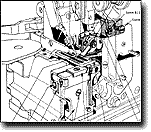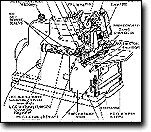OUT OF THE BOX
1) Upon removing the machine from its box observe its threading carefully and compare it with the threading diagram supplied with the machine.
 |
Keep this threading diagram for future reference. The matter of threading is very important and if difficulty arises, the threading of the machine should be compared with the individual diagram supplied. Threading is simple, but it must be accurate.
2) Secure the machine mounting assembly to the table with the three screws provided. This assembly should be:
Parallel with the center line of the motor. When the machine is set on the assembly, the front of the machine will be three or four inches back from the front of the table with its hand wheel to the right of the operator. The hand wheel belt groove should line up with the motor pulley groove, when the motor pulley is in the running position.
 |
3) Check the Hand Wheel (belt) Guard to be sure it does not hit the belt. Adjust if necessary; by removing screw, repositioning, and replacing screw.
4) Assemble thread stand and screw its base to the table at the rear of the machine.
5) The thread guides at the top of the thread stand should be directly over the center of the cones of thread.
6) The thread or yarn should be wound on cones, which should stand vertically. The thread from these cones should lead up to the Safety Cross Rod (8-52-J) through the thread eyes and diagonally downward to the machine. Note: The Safety Cross Rod should be installed with the thread eyes below the rod. Care should be taken to be sure the threads are far enough apart so that they will not whip together when the machine is running at speed.
7) Be sure the thread will come off the cones readily, with uniform tension and that it cannot catch under the cone or elsewhere along its path.
8) Since the oil has been drained from the machine before shipping, the main reservoir must be filled before the machine is used. (Note section 15)
SPEED
9) The Merrow Class MG and Class M machines are designed to run at maximum speed of 5500 stitches per minute. Some work is efficiently handled at 5500 stitches per minute but it has been found that maximum efficiency for some operations is attained at a speed of about 5000 stitches per minute.
MOTOR
10) To obtain full efficiency the motor must be kept in good operating condition in order to start and stop the machine with minimum delay. Every attempt should be made to avoid driving the hand wheel from an oversize pulley, especially when the centers of both pulleys are relatively close together. Failure to avoid this situation can result in belt slippage and less control of starting and stopping the machine.
11) A V-Belt Hand Wheel with an effective pitch diameter of 2 1/8" is supplied with each machine. A standard 3/8" endless V-Belt is recommended to connect the Hand Wheel to the motor pulley.
12) The top of the hand wheel must turn away from the operator. The machine sews with clockwise rotation only (when viewed from the Hand Wheel).
13) Consult you nearest Merrow Distributor to assure proper motor set up.











